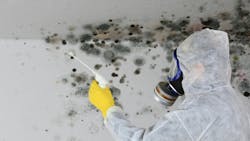The Links Between Climate Change and Mold and Mildew Proliferation in Commercial Buildings
Most of us have dealt with mold and mildew before. Brought into our homes by high levels of humidity, inclement weather or leaky pipes, what starts as an inconvenience often turns quickly into a serious problem. Mold and mildew have various effects on our health and wellbeing and can also erode property value if left untreated.
However, few have considered that the approaching climate crisis, which is already causing alarm across various sectors, might make this particular issue significantly worse. As weather continues to fluctuate due to high greenhouse gas levels, building and facilities professionals might wonder: how much worse will the mold issue get?
In this article, we’ll explore the links between climate change and property value, teach you how to differentiate between mold and mildew, and outline several strategies for preventing and eradicating buildup.
Climate Change and Property Value: Connected?
Firstly, let’s quantitatively define exactly how climate change may come to impact property value. As the climate continues to change, we are expected to see rising sea levels, increased dampness and mold, increased heavy precipitation, as well as a greater quantity of tropical storms and extreme weather events. While some of these events will have drastic and obvious impacts on property value, like flooding, others will have more subtle effects on property value.
We expect that climate change will impact property value in a variety of ways, including:
- Extreme weather risks: As the likelihood of extreme weather in an area spikes, property values in that area may decline. Demand for property in that area will fall, causing the value of commercial properties to depreciate over time.
- Cost-of-living spikes: Similarly, an increased likelihood of climate disasters may impact both insurance premiums and utility prices. As both climb, property owners may find themselves paying more to maintain the same properties, even as demand for those properties continues to decrease.
- Environmental damage: Weather patterns can also impact the local flora and fauna, slowly eroding the natural ecosystem of the area. This has an impact on your property’s presentation, eating away at the natural beauty of the surrounding landscape, and can also have negative impacts on air and water quality.
A more subtle way that climate change impacts property value is by making the accumulation of mold and mildew more likely. Heavy rainfall, flooding and even a higher degree of daily humidity can cause a higher likelihood of water damage, allowing mold and mildew to spawn and spread throughout your property. Carpets, drywall and furniture are all at risk; as well as the health of any tenants inside.
Mold and Mildew: The Effects
Mold and mildew are often used interchangeably to describe the same phenomenon. But as the likelihood of mold and mildew cropping up increases, knowing everything you can about these issues unlocks the fastest path to resolving them.
Mildew is typically harder to detect, a thin white or gray powdery film that emits a low, musty odor. Mold, on the other hand, is fuzzy and clumpy, and has a powerful, pungent odor. Helpfully, most forms of mold are visually distinct from mildew, being black, red or green.
Identifying which issue you’re dealing with allows you to react quickly, protecting your property from further damage and tenants from suffering a wide variety of health effects. Mold and mildew can negatively impact tenants’ health, causing reputational damage and possibly legal liability if the issue isn’t dealt with quickly. These health effects can include:
- Allergic reactions
- Asthma attacks
- Hypersensitivity to substances
- Lung inflammation
- Lung infections
As climate change continues to advance the likelihood of fungal infestations within properties, being aware of the issue will be paramount to protect yourself, the property and any tenants from the potential impacts.
Strategies for Mold Prevention and Elimination
But how can you act proactively to prevent mold and mildew from cropping up; and if it does, how can you get rid of it? Let these best practices be your north star as you attempt to navigate this ever-growing issue:
Strategies for Prevention:
- Fix leaks and install leak detection systems throughout your property.
- Monitor and adjust for high levels of humidity.
- If flooding or leaks occur, remove water-damaged materials from the property as soon as possible.
- Check the exterior of your building for groundwater accumulation; if needed, remove groundwater via downspouts and regrading.
Strategies for Elimination:
- Any water-damaged materials, like carpet or furniture, that cannot be salvaged must be thrown out.
- Treat all affected surfaces with a high-quality mold remover or disinfectant.
- Similarly, clean porous surfaces throughout the building, as well as any adjacent areas to the infection.
- After cleaning, lay a mold-resistant coating over all previously affected areas, preventing the infection from returning.
Building and facilities professionals are no stranger to mold and mildew; the key, then, as climate change increases the likelihood of these conditions, is to remain vigilant. Leverage best practices to eliminate risks as they crop up, keep an eye on property health, and check in with tenants to ensure they’re properly maintaining their living space, and you’ll be set.
About the Author
Amanda Winstead
Amanda Winstead is a writer focusing on many topics including climate, construction, and technology. Along with writing she enjoys traveling, reading, working out, and going to concerts. If you want to follow her writing journey, or even just say hi you can find her on Twitter.
